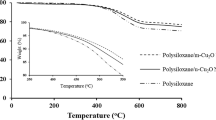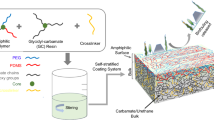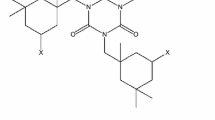Abstract
The concept of tethering quaternary ammonium salts (QASs) to a crosslinked polysiloxane matrix to produce a hybrid antifouling/fouling-release coating was investigated. A statistical experimental design was used to determine the effect of QAS concentration on biocidal activity toward a marine bacterium, Cellulophaga lytica (C. lytica). In addition to measuring biocidal activity, coating film quality as well as stability upon water immersion were evaluated. The results of the study showed that biocidal activity was strongly dependent on QAS concentration. For addition-curable coatings, the presence of 4 wt% QAS moieties resulted in approximately 50% reduction in C. lytica biofilm retention without any leachate toxicity. Attempts to increase the level of QAS moieties to increase biocidal activity resulted in coating delamination from the substrate and unacceptable film quality upon artificial seawater immersion due to excessive swelling. As a result, a moisture-curable system based on tethered QASs was investigated since moisture curing allows for higher crosslink densities to be achieved which would be expected to minimize swelling upon artificial seawater immersion. The moisture-curable coating developed showed enhanced stability upon artificial seawater immersion, greater than 80% reduction in C. lytica biofilm retention, and greater than 90% reduction in biofilm growth for the marine algae, Navicula incerta.






Similar content being viewed by others
References
Yebra, DM, Kiil, S, Dam-Johansen, K (2004) Antifouling Technology-Past, Present and Future Steps Towards Efficient and Environmentally Friendly Antifouling Coatings. Prog. Org. Coat., 50, 75–104
Rascio, VJD (2000) Antifouling Coatings: Where Do We Go From Here. Corrosion Reviews, 18, 133–154
Cooney, JJ, Tang, RJ (1999) Quantifying Effects of Antifouling Paints on Microbial Biofilm Formation. Meth. Enzymol., 310, 637–645
Majumdar, P, Ekin, A, Webster, DC (2007) Thermoset Siloxane-Urethane Fouling Release Coatings. ACS Symposium Series (Smart Coatings), 957, 61–75
Callow, ME, Fletcher, RL (1994) The Influence of Low Surface Energy Materials on Bioadhesion - a Review. Int. Biodeter. Biodegr., 34, 333–348
Abarzua, S, Jakubowsky, S (1995) Biotechnological Investigation for the Prevention of Biofouling. I. Biological and Biochemical Principles for the Prevention of Biofouling. Mar. Ecol. Prog. Ser., 123, 301–312
Sauvet, G, Fortuniak, W, Kazmierski, K, Chojnowski, J (2003) Amphiphilic Block and Statistical Siloxane Copolymers with Antimicrobial Activity. J. Polym. Sci., Part A: Polym. Chem., 41(19), 2939–2948
Gottenbos, B, Busscher, HJ, van der Mei, HC, Nieuwenhuis, P (2002) Pathogenesis and Prevention of Biomaterial Centered Infections. J. Mater. Sci.: Mater. Med., 13(8), 717–722
Gottenbos, B, van der Mei, HC, Klatter, F, Nieuwenhuis, P, Busscher, HJ (2002) In vitro and in vivo Antimicrobial Activity of Covalently Coupled Quaternary Ammonium Silane Coatings on Silicone Rubber. Biomaterials, 23(6), 1417–1423
Lenoir, S, Pagnoulle, C, Detrembleur, C, Galleni, M, Jerome, R, “Antimicrobial Activity of Polystyrene Particles Coated by Photo-Crosslinked Block Copolymers Containing a Biocidal Polymethacrylate Block.” e-Polymers, 074 (2005)
Sauvet, G, Dupond, S, Kazmierski, K, Chojnowski, J (2000) Biocidal Polymers Active by Contact. II. Biological Evaluation of Polyurethane Coatings with Pendant Quaternary Ammonium Salts. J. Appl. Polym. Sci., 75(8), 1005–1012
Nurdin, N, Helary, G, Sauvet, G (1993) Biocidal Polymers Active by Contact. II. Biological Evaluation of Polyurethane Coatings with Pendant Quaternary Ammonium Salts. J. Appl. Polym. Sci., 50, 663–670
Hazziza-Laskar, J, Nurdin, N, Helary, G, Sauvet, G (1993) Biocidal Polymers Active by Contact. I. Synthesis of Polybutadiene with Pendant Quaternary Ammonium Groups. J. Appl. Polym. Sci., 50, 651–662
Hazziza-Laskar, J, Helary, G, Sauvet, G (1995) Biocidal Polymers Active by Contact. IV. Polyurethanes Based on Polysiloxanes with Pendant Primary Alcohols and Quaternary Ammonium Groups. J. Appl. Polym. Sci., 58, 77–84
Tashiro, T (2001) Antibacterial and Bacterium Adsorbing Macromolecules. Macromol. Mater. Eng., 286, 63–87
Nakagawa, Y, Hayashi, H, Tawaratani, T, Kourai, H, Horie, T, Shibasaki, I (1984) Disinfection of Water with Quaternary Ammonium Salts Insolubilized on a Porous Glass Surface. Appl. Environ. Microbiol., 47, 513–518
Tiller, JC, Liao, C-J, Lewis, K, Klibanov, AM (2001) Designing Surfaces That Kill Bacteria on Contact. Proc. Natl. Acad. Sci. U.S.A., 98(11), 5981–5985
Brady, RF Jr (1999) Properties Which Influence Marine Fouling Resistance in Polymers Containing Silicon and Fluorine. Prog. Org. Coat., 35, 31–35
Zhang Newby, BM, Chaudhury, MK (1997) Effect of Interfacial Slippage on Viscoelastic Adhesion. Langmuir, 13, 1805–1809
Zhang Newby, BM, Chaudhury, MK, Brown, HR (1995) Macroscopic Evidence of The Effect of Interfacial Slippage on Adhesion. Science, 269(5529), 1407–1409
Kohl, JG, Singer, IL (1999) Pull-off Behavior of Epoxy Bonded to Silicone Duplex Coatings. Prog. Org. Coat., 36, 15–20
Anderson, MJ, Whitcomb, PJ (1996) Optimization of Paint Formulations Made Easy with Computer-Aided Design of Experiments for Mixtures. JCT Coatings Tech., 68(856), 71–75
Anderson, MJ, Whitcomb, PJ (1998) Find the Most Favorable Formulations. Chem. Eng. Prog., 94(4), 63–67
Anderson, MJ, Whitcomb, PJ (2000) Design Experiments That Combine Mixture Components with Process Factors. Chem. Eng. Prog., 96(12), 27–31
Stafslien, SJ, Bahr, JA, Feser, JM, Weisz, JC, Chisholm, BJ, Ready, TE, Boudjouk, P (2006) Combinatorial Materials Research Applied to the Development of New Surface Coatings I: A Multiwell Plate Screening Method for the High-Throughput Assessment of Bacterial Biofilm Retention on Surfaces. J. Comb. Chem., 8(2), 156–162
Stafslien, S, Daniels, J, Chisholm, B, Christianson, D (2007) Combinatorial Materials Research Applied to the Development of New Surface Coatings III. Utilization of a High-Throughput Multiwell Plate Screening Method to Rapidly Assess Bacterial Biofilm Retention on Antifouling Surfaces. Biofouling, 23(1), 37–44
Casse, F, Stafslien, S, Bahr, J, Daniels, J, Finlay, J, Callow, J, Callow, M (2007) Combinatorial Materials Research Applied to the Development of New Surface Coatings V. Application of a Spinning Water-Jet for the Semi-High Throughput Assessment of the Attachment Strength of Marine Fouling Algae. Biofouling, 23(2), 121–130
Majumdar, P, Christianson, DA, Roesler, RR, Webster, DC (2006) Optimization of Coating Film Deposition When Using an Automated High Throughput Coating Application Unit. Prog. Org. Coat., 56, 169–177
Friendly, M (1994) Mosaic Displays for Multi-Way Contingency Tables. J. Am. Stat. Assoc., 89, 190–200
Hofmann, H (2000) Exploring Categorical Data: Interactive Mosaic Plots. Metrika, 51, 11–26
Author information
Authors and Affiliations
Corresponding author
Additional information
Presented at 2007 FutureCoat! Conference, sponsored by Federation of Societies for Coatings Technology, October 3–5, 2007, in Toronto, Ont., Canada.
Appendices
Appendices
Rights and permissions
About this article
Cite this article
Majumdar, P., Lee, E., Patel, N. et al. Development of environmentally friendly, antifouling coatings based on tethered quaternary ammonium salts in a crosslinked polydimethylsiloxane matrix. J Coat Technol Res 5, 405–417 (2008). https://doi.org/10.1007/s11998-008-9098-4
Published:
Issue Date:
DOI: https://doi.org/10.1007/s11998-008-9098-4




